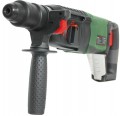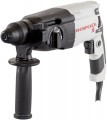Power consumption
Rated power consumed by the rotary hammer during operation. Usually, the maximum power consumption in normal operation is taken as the nominal power.
In general, the higher this indicator, the heavier and more performant the rotary hammer is, the more advanced its performance usually turns out to be. On the other hand, the electricity consumption of such tools is high. In addition, note that with the same power consumption, the actual set of individual characteristics for different tools may be different. For example, frequency and impact energy are inversely related, and for the same power input, higher frequency usually means less individual impact energy. So, according to this parameter, it is worth evaluating only the overall level of the instrument; for accurate selection for specific tasks, you need to pay attention to more specific characteristics.
Also note that power consumption data can be useful for some tasks related to catering — for example, if a construction site is powered by an autonomous generator and you need to estimate the load on this energy source.
Impact energy
The energy transmitted by the perforator to the material being processed upon impact; the higher this indicator, the stronger and more powerful each individual blow.
First of all, we recall that the energy of impacts is directly related to their frequency: an increase in frequency leads to a decrease in energy. Therefore, for models where the number of strokes can be adjusted, this paragraph usually gives the maximum energy achieved at the minimum speed of operation.
In general, higher impact energy improves efficiency when working with hard, stubborn materials, but requires more motor power (especially if it has to be combined with a high frequency). Therefore, it is worth choosing according to this parameter, taking into account specific tasks. So, for occasional use in everyday life, an energy of 2 J or less is enough, for home repair work of medium intensity, at least 3 J is desirable; a power of
4 J or more is already considered high; and in some industrial-grade perforators, this figure can reach 30 J.
Number of thrusts
The number of beats per minute provided by the punch. For models in which the beat frequency can be adjusted, this item indicates the entire adjustment range, for example "1600 — 3000".
High impact frequency, on the one hand, increases the productivity of the tool and can significantly reduce the time required for work. On the other hand, with the same engine power, an increase in the number of strokes per minute leads to a decrease in the energy of each stroke. Therefore, among heavy performant devices, a low frequency is often found — up to 2500 beats / min and even lower. And the ability to adjust the frequency of impacts allows you to adjust the hammer to the specific situation, depending on what is more important — productivity or the ability to cope with hard, stubborn material. For example, for old crumbling brickwork, you can set the speed higher, and for working with stone or dense concrete, it is better to reduce the frequency of impacts by directing engine power to increase the energy of each impact.
Summing up, we can say this: when choosing a perforator, you should focus on both the number of strokes and the impact energy. Detailed recommendations on this subject for specific situations can be found in special sources.
Rotation speed
The speed of rotation of the working equipment provided by the rotary hammer. Usually, this indicates the speed at idle, without load; rated load speeds can be further specified in the characteristics (see below), but this is rare, and this parameter is still considered the main characteristic. It is also worth mentioning that in the presence of a speed controller (see "Functions"), the maximum speed value is given here.
When working in the main mode — drilling with impact — the rotation of the equipment is used mainly to remove waste from the hole, and the revolutions here are of no fundamental importance (they can be very low). Therefore, it is worth paying attention to this indicator mainly in cases where the rotary hammer is planned to be often used for conventional drilling, without impact. And here it is worth proceeding from the fact that
high speeds increase productivity and contribute to accuracy when working with some materials, but reduce torque (compared to tools with the same engine power). So for heavy work with hard, stubborn materials, relatively "slow" tools are usually better suited.
Note also that drilling is not the main task of rotary hammers; therefore, their rotation speeds are noticeably lower than those of the same
drills. On the other hand, in this case, low speeds are often compensated by powerful engines and high torque, which makes it possible to effectively drill holes
...of a fairly large diameter, including using crowns.Reverse
The reverse allows you to switch the direction of rotation of the nozzle. It also indicates the type of switch responsible for the reverse. The options might be:
—
Crawler. A switch in the form of a slider with two working positions (plus a neutral one between them, at which the tool does not turn on at all). Usually, it is able to move in the direction "back and forth" — this option is considered the most practical. The sliders are quite simple and at the same time convenient and visual.
—
Flag. A switch in the form of a flag, usually installed above the start button and thrown to the right and left. One of the advantages of the checkbox is that it is right at your fingertips and can be switched almost “without unnecessary movements” (which is not always available for the slider).
—
Brush (on the engine). The brush reverse differs from the two options described above not so much in the design of the switch as in the principle of operation: it changes the direction of rotation not by controlling the current on the motor windings, but by a special movable brush holder for this motor. This allows you to develop maximum power in any direction of rotation (which is not always available with electronic adjustment), and also reduces wear on individual engine components. The disadvantages of this option are complexity an
...d high cost.
— Gearbox. A rather specific option: switching the direction due to the settings of the gearbox (the mechanism that transmits rotation from the engine to the cartridge). Here you can draw an analogy with turning on the reverse gear in a car: turning on the reverse affects only the cartridge with the tooling, the tool motor continues to rotate in the same direction. This allows you to use the full power of the motor in any direction of rotation; and the absence of unnecessary switches has a positive effect on the reliability of the electrical components of the tool. On the other hand, gears with a reverse function are quite complex and expensive, and therefore they are rarely found in individual professional-grade rotary hammers. Chuck type
The type of cartridge used in a rotary hammer to hold a working tool.
—
SD+. Abbreviation for it. "Steck-Dreh-Sitzt" — "insert-turn-fixed." Today's most common rotary hammer chuck, used in low and medium power models. It has a 10mm diameter shank with 4 slots and accepts tools from 4 to 26mm in diameter and 110mm to 1000mm in length. The advantages of SDS + are the reliability of fastening and convenience when changing tools — it does not require additional devices such as keys. The main drawback is the significant beating of the tool during rotation, due to which such a cartridge is very poorly suitable for drilling.
—
SDS Max. Modification of the SDS + cartridge (see above), intended for use in powerful professional models. It has a shank diameter of 18 mm and allows the use of tools with a diameter of up to 55 mm; otherwise similar to SDS+.
—
SDS-Quick. A variation of the SDS cartridge (see above), in the shank under which protrusions are used instead of grooves. It is also possible to install tools with 1/4" hex shanks in such a chuck. The most common tool diameter for SDS-Quick is 4-10 mm. This chuck is used relatively rarely.
—
Quick release. Chuck for holding drills and other tools used in drilling holes. The design is similar to those used in electric drills — it has 3 cams, it is designed for a too
...l with a cylindrical shank without grooves, and hand force is enough to install / remove the tool. Such a cartridge is devoid of the main drawback of SDS — beats during rotation; this allows you to use the rotary hammer for drilling with good quality. On the other hand, it is much worse for chiselling than SDS. Therefore, keyless chucks are usually supplied as an accessory and are installed instead of the standard SDS chuck.
— Key. The presence of a special key cartridge in the delivery set of the rotary hammer, usually in addition to the standard SDS (see above). In terms of mounting design, this chuck is similar to the keyless chuck (see above) and is also designed for use in drilling. Its main difference lies in the method of installing / removing the tool: you can’t do this with your bare hands, you must use a special key to compress / unclench the cams. Such a system is somewhat more reliable than a quick-clamping system, but much less convenient: changing a tool takes a lot of time, and the key can be lost.Quick chuck change
Possibility of
quick replacement of the perforator chuck — usually from a regular SDS to a quick-clamping one (for more details, see "Chuck type"). Such replacement is carried out in a few seconds and does not require additional tools.
Wood drilling max. ⌀
The maximum diameter of a tool that can be used with a rotary hammer when drilling in wood (and, accordingly, the maximum diameter of the resulting hole). With a large drilling diameter, the loads on the device increase, and some models may simply not be designed for them (despite the technical possibility of installing tools of the appropriate diameter), as a result, it is not worth exceeding the maximum specified diameter, because. this may damage the instrument.
Metal drilling max. ⌀
The maximum tool diameter that can be used with a rotary hammer when drilling in metal. See "Maximum drilling diameter in wood" for details.

